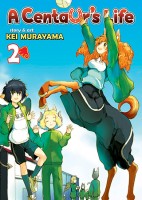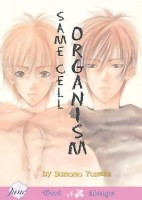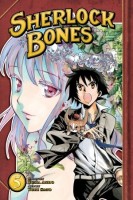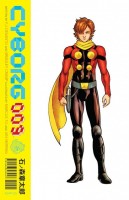My News and Reviews
I posted two in-depth manga reviews at Experiments in Manga last week. The first was of Baku Yumemakura and Jiro Taniguchi’s The Summit of the Gods, Volume 3. It’s the middle volume of a five-volume, award-winning series and is a critical turning point for the story and characters. The Summit of the Gods is my favorite Taniguchi collaboration as well as one of my favorite manga series in general. And if manly mountain men don’t interest you, perhaps my review of Mari Okazaki’s out-of-print josei collection Sweat & Honey might entice you to track down a copy for yourself. The short manga included in the anthology focus on the close and often complicated relationships between women. The post is a part of my Year of Yuri monthly review project and makes the seventh installment. Only five more reviews to go!
Elsewhere online there were plenty of interesting things to read. Yen Press has a new set of license announcements. Organization Anti-Social Geniuses had two posts last week that I particularly liked: an interview with Cho, the founder of the site English Light Novels (which is an incredibly useful resource that I was previously unaware of), and a look at some of the reasons why people tell publishers they read illegal version of manga. Otaku USA has a nice interview with Helen McCarthy, whose newest book A Brief History of Manga will be released soon. The Lobster Dance has posted Revealing and Concealing Identities: Cross-Dressing in Anime and Manga, Part 4, with at least one more part to come. Lastly, the second manga studies column at Comics Forum is now available, focusing on the history of manga and Kitazawa Rakuten.
Quick Takes
 A Centaur’s Life, Volumes 2-3 by Kei Murayama. The more I read of A Centaur’s Life, the more I like the series. It can be incredibly sweet and adorable, and Murayama’s world-building is fascinating. Not all of that world-building makes it into the series proper (at least not yet), but the extra material between chapters and at the beginning and end of the volumes. Is interesting, delving into the politics, history, and mythology of A Centaur’s Life. It’s obvious that a lot of thought has been put into the series to make it as realistic as possible; Murayama takes into account even the smallest details of everyday life and how things like cars, furniture, and buildings have to be modified to accommodate races with completely different anatomies. A Centaur’s Life is fairly episodic, but more and more recurring characters are introduced as the series progresses. These two volumes in particular frequently feature the youngest generation of centaurs and other folk. Like any kids, they can be hellions but they can be super cute, too.
A Centaur’s Life, Volumes 2-3 by Kei Murayama. The more I read of A Centaur’s Life, the more I like the series. It can be incredibly sweet and adorable, and Murayama’s world-building is fascinating. Not all of that world-building makes it into the series proper (at least not yet), but the extra material between chapters and at the beginning and end of the volumes. Is interesting, delving into the politics, history, and mythology of A Centaur’s Life. It’s obvious that a lot of thought has been put into the series to make it as realistic as possible; Murayama takes into account even the smallest details of everyday life and how things like cars, furniture, and buildings have to be modified to accommodate races with completely different anatomies. A Centaur’s Life is fairly episodic, but more and more recurring characters are introduced as the series progresses. These two volumes in particular frequently feature the youngest generation of centaurs and other folk. Like any kids, they can be hellions but they can be super cute, too.
 Same Cell Organism by Sumomo Yumeka. Much like Yumeka’s later manga, The Day I Become a Butterfly, Same Cell Organism tends to be fairly quiet and subdued. Yumeka’s artwork is lovely, with a light, airy touch to it, though her character designs from one story to the next are similar enough to cause some brief confusion from time to time. Same Cell Organism is a collection of some of her earliest boys’ love manga. It’s a somewhat uneven volume, mostly do to the fact that one of the stories, “To Make an Angel” was never actually completed. All of the set up is there, but then it suddenly ends with no real conclusion. However, I absolutely adored the titular story “Same Cell Organism” and its subsequent chapters. The story follows two young men in high school who might seem like unlikely friends because their personalities are so different: Yokota is loud, enthusiastic, and outgoing while Nakagawa is much quieter and reserved and has a more difficult time expressing himself. However, their relationship develops naturally and is delightfully loving and sweet.
Same Cell Organism by Sumomo Yumeka. Much like Yumeka’s later manga, The Day I Become a Butterfly, Same Cell Organism tends to be fairly quiet and subdued. Yumeka’s artwork is lovely, with a light, airy touch to it, though her character designs from one story to the next are similar enough to cause some brief confusion from time to time. Same Cell Organism is a collection of some of her earliest boys’ love manga. It’s a somewhat uneven volume, mostly do to the fact that one of the stories, “To Make an Angel” was never actually completed. All of the set up is there, but then it suddenly ends with no real conclusion. However, I absolutely adored the titular story “Same Cell Organism” and its subsequent chapters. The story follows two young men in high school who might seem like unlikely friends because their personalities are so different: Yokota is loud, enthusiastic, and outgoing while Nakagawa is much quieter and reserved and has a more difficult time expressing himself. However, their relationship develops naturally and is delightfully loving and sweet.
 Say I Love You, Volume 2 by Kanae Hazuki. I was a little surprised by how much I enjoyed the first volume of Say I Love You and so was very interested in seeing how the characters’ stories and relationships continued to develop in the second. I particularly like the leads, Mei and Yamato. Mei especially is marvelous; she’s confident enough in herself to avoid bad situations involving other people, which made me very happy to see. Yamato obviously cares for Mei and is very respectful of her. However, many of the other characters aren’t likeable at all, and much of the second volume is devoted to them. Hayakawa is a womanizer and an absolute asshole. His story arc in this volume is a bit uncomfortable—he gets his comeuppance, but he also gets the girl. (I worry about her, so I truly hope that his colors have changed having been redeemed by love.) Aiko, who apparently used to be a lovely young woman, is simply not a nice person at all anymore. She has her reasons, but she’s still not sympathetic. Say I Love You deals very honestly with sex and its emotional repercussions at such a young age. Some of the relationships in the series aren’t at all healthy, making the budding romance between Mei and Yamato refreshing in comparison.
Say I Love You, Volume 2 by Kanae Hazuki. I was a little surprised by how much I enjoyed the first volume of Say I Love You and so was very interested in seeing how the characters’ stories and relationships continued to develop in the second. I particularly like the leads, Mei and Yamato. Mei especially is marvelous; she’s confident enough in herself to avoid bad situations involving other people, which made me very happy to see. Yamato obviously cares for Mei and is very respectful of her. However, many of the other characters aren’t likeable at all, and much of the second volume is devoted to them. Hayakawa is a womanizer and an absolute asshole. His story arc in this volume is a bit uncomfortable—he gets his comeuppance, but he also gets the girl. (I worry about her, so I truly hope that his colors have changed having been redeemed by love.) Aiko, who apparently used to be a lovely young woman, is simply not a nice person at all anymore. She has her reasons, but she’s still not sympathetic. Say I Love You deals very honestly with sex and its emotional repercussions at such a young age. Some of the relationships in the series aren’t at all healthy, making the budding romance between Mei and Yamato refreshing in comparison.
 Sherlock Bones, Volume 5 written by Yuma Ando and illustrated by Yuki Sato. Sherlock Holmes reincarnated as a puppy is still a rather silly premise, but I’ll admit that I’ve largely been enjoying the series. Occasionally there’s an unnecessary flash of underwear, but generally that’s fairly easy to pass over. The mysteries in the series are interesting with some very clever, though sometimes outlandish, twists. The artwork provides clues for readers to pick up on if they’d like a more interactive story experience, too. One of the things that I actually liked best about this particular volume of Sherlock Bones is that the story moves from Takeru being a high school student to his entry into the workforce. Unsurprisingly, coming from a police family and considering his recent work solving crimes with Sherdog, Takeru becomes a patrol officer. Already it’s proving to supply even more cases for him and Sherdog to investigate, and a few new characters are introduced as well. Sherlock Bones continues to be an entertaining series, and I look forward to reading the remaining two volumes.
Sherlock Bones, Volume 5 written by Yuma Ando and illustrated by Yuki Sato. Sherlock Holmes reincarnated as a puppy is still a rather silly premise, but I’ll admit that I’ve largely been enjoying the series. Occasionally there’s an unnecessary flash of underwear, but generally that’s fairly easy to pass over. The mysteries in the series are interesting with some very clever, though sometimes outlandish, twists. The artwork provides clues for readers to pick up on if they’d like a more interactive story experience, too. One of the things that I actually liked best about this particular volume of Sherlock Bones is that the story moves from Takeru being a high school student to his entry into the workforce. Unsurprisingly, coming from a police family and considering his recent work solving crimes with Sherdog, Takeru becomes a patrol officer. Already it’s proving to supply even more cases for him and Sherdog to investigate, and a few new characters are introduced as well. Sherlock Bones continues to be an entertaining series, and I look forward to reading the remaining two volumes.





